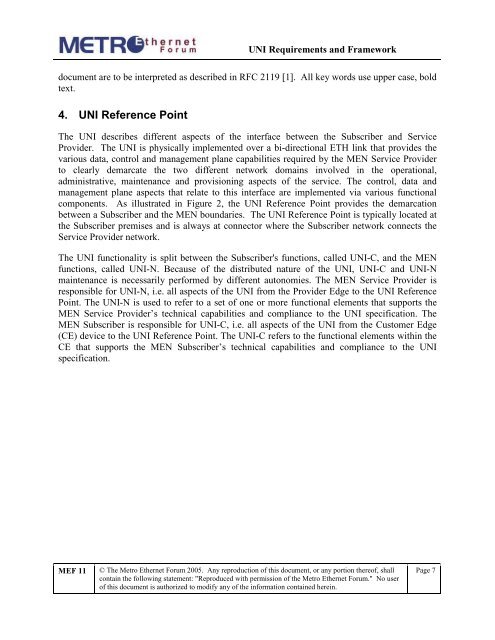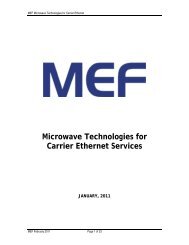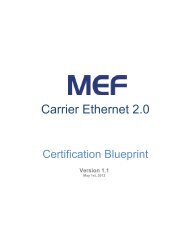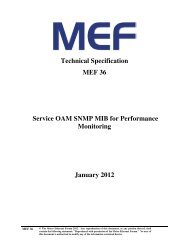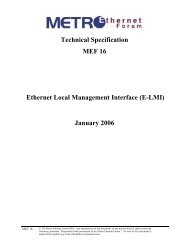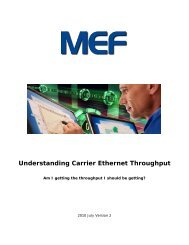User Network Interface (UNI) Requirements and Framework - MEF
User Network Interface (UNI) Requirements and Framework - MEF
User Network Interface (UNI) Requirements and Framework - MEF
Create successful ePaper yourself
Turn your PDF publications into a flip-book with our unique Google optimized e-Paper software.
<strong>UNI</strong> <strong>Requirements</strong> <strong>and</strong> <strong>Framework</strong><br />
document are to be interpreted as described in RFC 2119 [1]. All key words use upper case, bold<br />
text.<br />
4. <strong>UNI</strong> Reference Point<br />
The <strong>UNI</strong> describes different aspects of the interface between the Subscriber <strong>and</strong> Service<br />
Provider. The <strong>UNI</strong> is physically implemented over a bi-directional ETH link that provides the<br />
various data, control <strong>and</strong> management plane capabilities required by the MEN Service Provider<br />
to clearly demarcate the two different network domains involved in the operational,<br />
administrative, maintenance <strong>and</strong> provisioning aspects of the service. The control, data <strong>and</strong><br />
management plane aspects that relate to this interface are implemented via various functional<br />
components. As illustrated in Figure 2, the <strong>UNI</strong> Reference Point provides the demarcation<br />
between a Subscriber <strong>and</strong> the MEN boundaries. The <strong>UNI</strong> Reference Point is typically located at<br />
the Subscriber premises <strong>and</strong> is always at connector where the Subscriber network connects the<br />
Service Provider network.<br />
The <strong>UNI</strong> functionality is split between the Subscriber's functions, called <strong>UNI</strong>-C, <strong>and</strong> the MEN<br />
functions, called <strong>UNI</strong>-N. Because of the distributed nature of the <strong>UNI</strong>, <strong>UNI</strong>-C <strong>and</strong> <strong>UNI</strong>-N<br />
maintenance is necessarily performed by different autonomies. The MEN Service Provider is<br />
responsible for <strong>UNI</strong>-N, i.e. all aspects of the <strong>UNI</strong> from the Provider Edge to the <strong>UNI</strong> Reference<br />
Point. The <strong>UNI</strong>-N is used to refer to a set of one or more functional elements that supports the<br />
MEN Service Provider’s technical capabilities <strong>and</strong> compliance to the <strong>UNI</strong> specification. The<br />
MEN Subscriber is responsible for <strong>UNI</strong>-C, i.e. all aspects of the <strong>UNI</strong> from the Customer Edge<br />
(CE) device to the <strong>UNI</strong> Reference Point. The <strong>UNI</strong>-C refers to the functional elements within the<br />
CE that supports the MEN Subscriber’s technical capabilities <strong>and</strong> compliance to the <strong>UNI</strong><br />
specification.<br />
<strong>MEF</strong> 11<br />
© The Metro Ethernet Forum 2005. Any reproduction of this document, or any portion thereof, shall<br />
contain the following statement: "Reproduced with permission of the Metro Ethernet Forum." No user<br />
of this document is authorized to modify any of the information contained herein.<br />
Page 7


